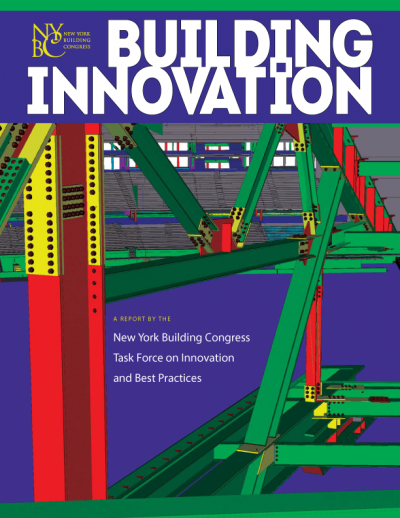
Building Innovation
Best Practices in Project Delivery
Best Practices in Project Delivery
 |
|
|
7 Bryant Park - Lean Construction Project, Credit: Turner Construction Company |
Everyone involved in the construction process has a stake in delivering projects faster, more safely, and at a lower cost - from the project owners who want high quality buildings and improved bottom lines, to the contractors and designers who want to satisfy clients while maximizing productivity and profitability. These goals can be advanced by increasing efficiency in every phase of a project life cycle.
"The first step towards more efficient construction is to recognize when and where there is waste in the current processes," explained Charles F. Murphy, Senior Vice President of Turner Construction Company and Co-Chairman of the Building Technology and Project Delivery Committee. "Once those wastes are identified, long-term Lean construction strategies can be developed to address them."
Lean is a modern approach to construction aimed at eliminating waste through continuous improvements to design and construction processes. The concept of Lean is credited to the manufacturing industry, beginning with Henry Ford's efforts to improve efficiency in the automotive industry, which later inspired Toyota Motor Company to create a systematic approach to continuous improvement. Since it was pioneered in the construction industry more than 25 years ago, Lean construction has evolved into a transformative business strategy that embraces widespread collaboration, promotes the standardized use of advanced building practices, and leverages new technologies.
The Task Force formed six working groups that used Lean concepts of Value, Value Stream, Flow, Pull, and Continuous Improvement to evaluate and find opportunities to improve the construction processes of six building systems: foundations, structure, electrical, mechanical, enclosure, and drywall/finishes.
Composed of Lean practitioners, owners, architects, engineers, trades, and general contractors to ensure a diverse range of perspectives and knowledge, each working group was assigned a building system and developed a Value Stream Map (VSM) for it. Value Stream Mapping offers a routine method of analyzing all the steps in a process to identify the wastes, such as errors, rework, transportation, and underutilized talent, and then develop countermeasures to reduce them.
The working groups documented the steps in the current construction process of each building system and measured the following:
Process Time: The number of working hours spent on process steps (not including waiting time).
Down Time: The number of working hours spent making revisions or waiting for information or a deliverable.
Percent Complete and Accurate: The percent of occurrences where a process step is completed without needing corrections or requesting missing information.
By looking at the process steps as a whole, the working groups were able to detect weaknesses and persistent points of failure as well as spot the areas with the greatest opportunity for improvement - namely, those steps with high Down Time and low Percent Complete and Accurate.
For example, a VSM of the current processes for foundations and structural steel from bid and award to the creation of shop drawings revealed that both typically take much longer than necessary due to rework. Foundations bid and award phases occupy 6-7 months and the development of shop drawings an additional 2-3 months, whereas the steel bid and award phases occupy 12 or more months and development of shop drawings an additional 5-6 months.
The VSM exposed areas of wasted effort, demonstrating that each process presently cycles through at least 6 months of rework in the award and shop drawing phases alone. In particular, the VSM showed that Requests for Information (RFIs) and addendums result in overproduction and underutilized personnel. In addition, incomplete documents at the beginning of the processes cause a lack of integration and transparent communication downstream.
The foundations and structure working groups identified potential measures to improve the processes, focusing on increasing collaboration and the implementation of common standards. These include beginning both processes with a fully dimensioned and coordinated model, working with a common set of PDF standards and a common technology platform, and getting the trades involved earlier in the process.
The VSMs for the other building systems likewise exposed wastes that could be readily "leaned." While there were some variations among the wastes associated with each building system process, the Task Force's most striking discovery was that current construction processes are extremely duplicative and redundant across the board. The good news is that applying Lean principles and practices offers opportunities to address these and other inefficiencies, yielding tangible benefits, such as better quality, improved safety, faster completion, reduced costs, and increased value to the owner.
Unfortunately, Lean construction is not as widely adopted and implemented as it should be. According to a McGraw Hill Construction Smart- Market Report, "Lean Construction - Leveraging Collaboration and Advanced Practices to Increase Project Efficiency", Lean practitioners and non-practitioners alike cited lack of knowledge and understanding of Lean as the key challenges to its implementation. Employee resistance also made the list of significant challenges, though most Lean experts reported that employees become enthusiastic and engaged after they experience the benefits of Lean.
"An industry shift towards Lean requires a cultural renaissance of building practices that begins with education," said Carl Galioto, Managing Principal of HOK and Co-Chairman of the Building Technology and Project Delivery Committee. "The industry needs to become better informed about the inefficiencies in current construction processes and the ways in which taking a Lean approach can make real and substantial improvements in the delivery and quality of projects."
As Lean is still an emerging practice in the building industry, the Task Force recommends the following to help it gain a stronger foothold:
- Industry associations should offer more information about Lean, including by sponsoring research to demonstrate the need for greater efficiencies and by actively promoting Lean's core tenet of continual improvement.
- Lean practitioners should encourage their industry partners to learn more about and adopt Lean principles and practices.
- Public and private owners should demand the use of Lean practices in the delivery of their projects.



